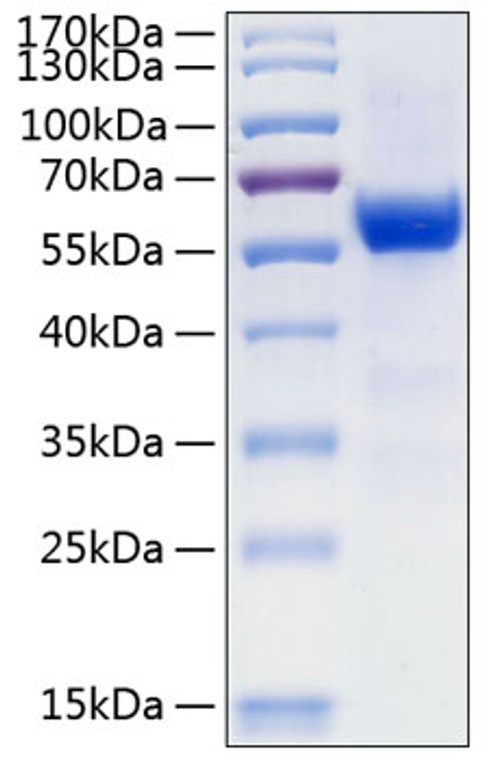| Host: |
HEK293 cells |
| Reactivity: |
Human |
| Note: |
STRICTLY FOR FURTHER SCIENTIFIC RESEARCH USE ONLY (RUO). MUST NOT TO BE USED IN DIAGNOSTIC OR THERAPEUTIC APPLICATIONS. |
| Short Description: |
Recombinant-Human Frizzled-7/FZD7-C-hFc&His protein was developed from hek293 cells and has a target region of C-hFc&His. For use in research applications. |
| Formulation: |
Lyophilized from a 0.22 Mu m filtered solution of PBS, pH 7.4. Contact us for customized product form or formulation. |
| Immunoreactivity: |
Measured by its binding ability in a functional ELISA. Immobilized Human Glypican-3 Protein at 5 Mu g/mL (100 Mu L/well) can bind Human FZD7 with a linear range of 4.88-935.5 ng/mL.2. Measured by its binding ability in a functional ELISA. Immobilized |
| Gene Symbol: |
FZD7 |
| Gene ID: |
8324 |
| Uniprot ID: |
FZD7_HUMAN |
| Immunogen: |
Recombinant Human Frizzled-7/FZD7 Protein is produced by HEK293 cells expression system. The target protein is expressed with sequence (Gln33-Leu185) of human Frizzled-7 (Accession #NP_003498.1) fused with an Fc, 6×His tag at the C-terminus. |
| Tissue Specificity | High expression in adult skeletal muscle and fetal kidney, followed by fetal lung, adult heart, brain, and placenta. Specifically expressed in squamous cell esophageal carcinomas. |
| Post Translational Modifications | Ubiquitinated by ZNRF3, leading to its degradation by the proteasome. |
| Function | Receptor for Wnt proteins. Most frizzled receptors are coupled to the beta-catenin canonical signaling pathway, which leads to the activation of disheveled proteins, inhibition of GSK-3 kinase, nuclear accumulation of beta-catenin and activation of Wnt target genes. A second signaling pathway involving PKC and calcium fluxes has been seen for some family members, but it is not yet clear if it represents a distinct pathway or if it can be integrated in the canonical pathway, as PKC seems to be required for Wnt-mediated inactivation of GSK-3 kinase. Both pathways seem to involve interactions with G-proteins. Activation by WNT8 induces expression of beta-catenin target genes. Following ligand activation, binds to CCDC88C/DAPLE which displaces DVL1 from FZD7 and leads to inhibition of canonical Wnt signaling, activation of G-proteins by CCDC88C and triggering of non-canonical Wnt responses. May be involved in transduction and intercellular transmission of polarity information during tissue morphogenesis and/or in differentiated tissues. (Microbial infection) Acts as a receptor for C.difficile toxin TcdB in the colonic epithelium. |
| Protein Name | Frizzled-7Fz-7Hfz7Fze3 |
| Database Links | Reactome: R-HSA-373080Reactome: R-HSA-4086400Reactome: R-HSA-4608870Reactome: R-HSA-9673324 |
| Cellular Localisation | Cell MembraneMulti-Pass Membrane ProteinEndosome MembraneAssociated To The Plasma Membrane In The Presence Of Fzd7 And Phosphatidylinositol 45-Bisphosphate (Pip2)Localized In Recycling Endosomes In Other Conditions |
| Alternative Protein Names | Frizzled-7 proteinFz-7 proteinHfz7 proteinFze3 proteinFZD7 protein |
Information sourced from Uniprot.org
12 months for antibodies. 6 months for ELISA Kits. Please see website T&Cs for further guidance









